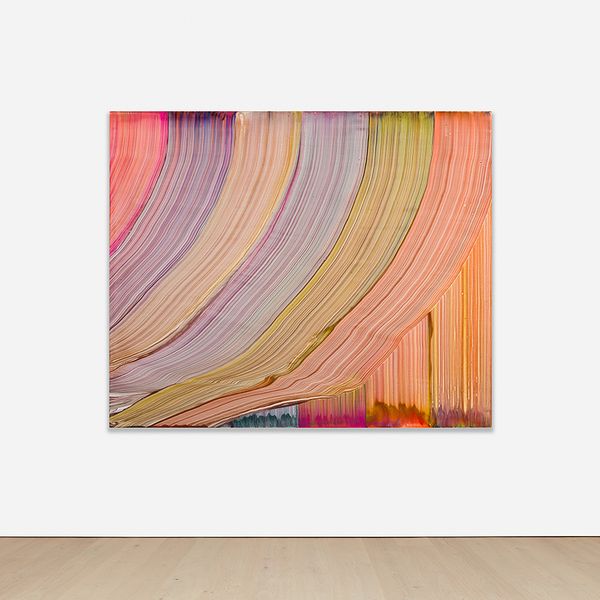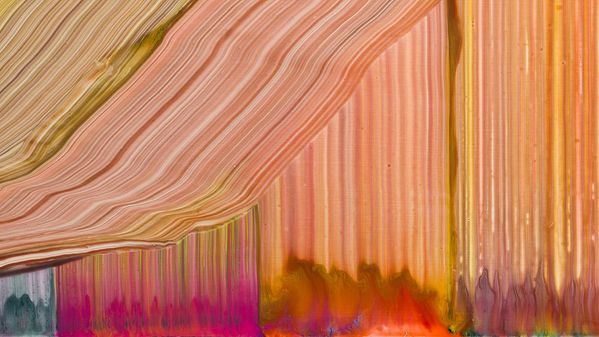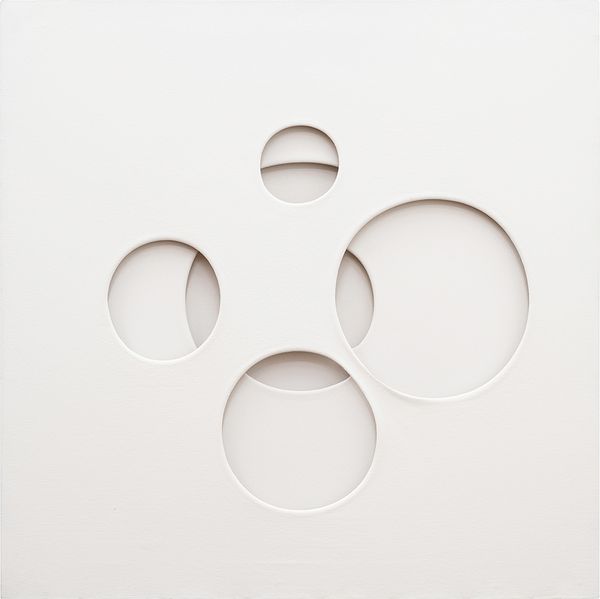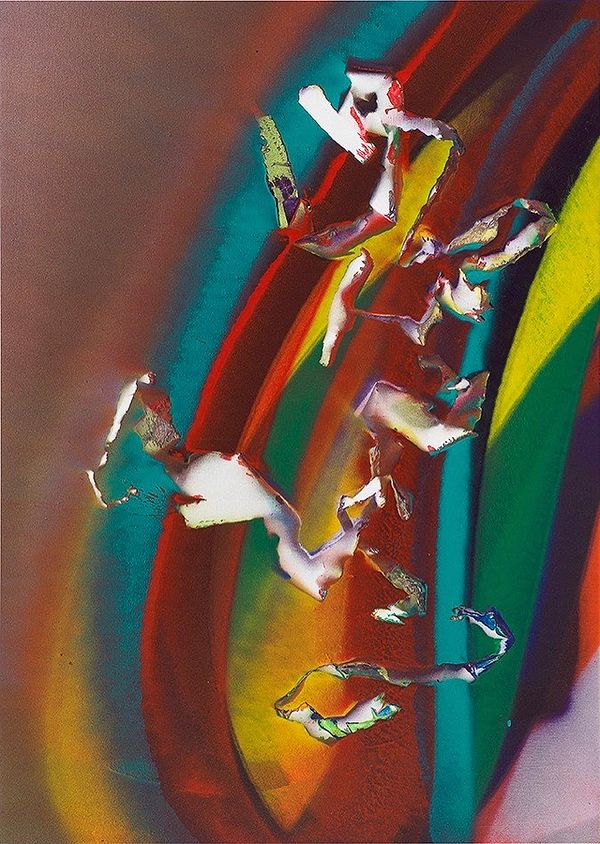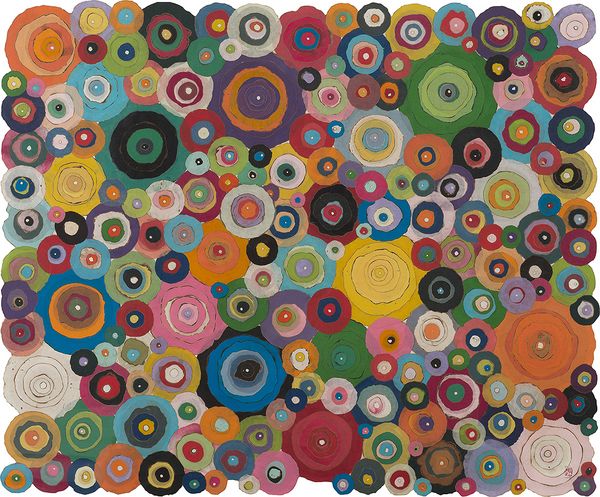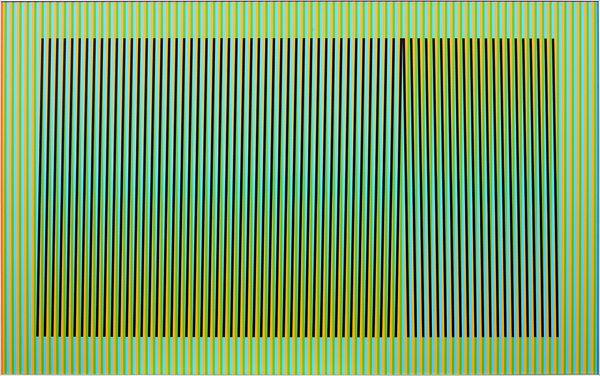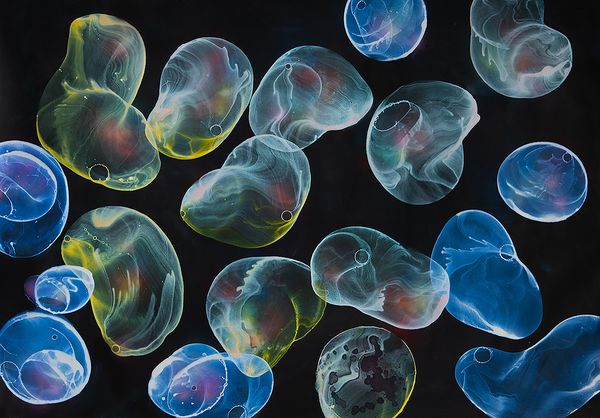Bernard Frize, Risti, 2004. 20th Century & Contemporary Art Day Sale London.
The internet abounds with articles and Tik-Toks encouraging beginner DIY painters to visit their local craft shop and pick up some acrylic paints. The benefits are clear, they all say: even artist-grade acrylic paints are more affordable than oils, working with acrylic doesn’t require the strong ventilation of a professional studio, acrylics adhere to most surfaces, and they dry exceptionally quickly. Though this pervasive content may have led to a cultural perception of acrylic as a lesser material, countless artists — particularly young painters with limited resources — have turned this idea on its head, producing acclaimed work utilizing acrylic and often other craft materials (Mickalene Thomas comes to mind). Sometimes they even shatter auction records along the way.
Beyond the fact that improved manufacturing processes have strengthened the quality of artist-grade acrylic paint since the material was first marketed in the 1950s (when its early champions included David Hockney), acrylic paint isn’t always the second choice. Sometimes, an abstract visual idea is so specific that the idea itself guides the choice of medium, not external factors. And for the painters below — who utilize acrylic paint and a variety of unexpected materials to service their artistic needs — it’s the only choice.
Bernard Frize
Bernard Frize, Risti, 2004. 20th Century & Contemporary Art Day Sale London.
Bernard Frize’s distinctive process-driven approach calls for thin, translucent paint that dries quickly. Having entered art school following the wave of student protests in May 1968, Frize rejected painterly approaches that would either outwardly depict or entirely ignore his political convictions regarding class and labor. He eventually stopped painting for a decade to consider how to imbue his social beliefs in the way his paintings were made, not just how they appear: “I was looking for a way to be modern in painting, a way to be contemporary with my time, as the Impressionists had been in the 19th century,” Frize explained to Olivier Zahn in an interview for Purple Magazine in 2016. He went on to share that “because the revolution — as we believed — was supposed to come from the working class, I wanted to work out my painting in an extremely modest way. I wanted to turn out art that wouldn’t distinguish itself from the work of a factory worker.”
Bernard Frize, Risti (detail), 2004. 20th Century & Contemporary Art Day Sale London.
Painting on canvases placed flat on the floor of his Berlin studio, Frize works quickly with very transparent, liquid colors and according to carefully developed processes that explore chance within a set of strict parameters. Working in series, Frize explores the same set of parameters multiple times to produce every possible execution of them. It’s a practice that attempts to remove the artist’s individual expressive choices, akin to the experience of worker on a production line. Stating that he takes approximately 10 minutes to paint a canvas once the process is determined, Frize piles layers of translucent acrylic and resin rapidly, using different colors at random simply to keep track of where he is in the process — a practice that would be impossible with oil paint. The resulting works are colorful visual pleasures that invite us to question the subjectivity of the act of painting and its effect on the resulting objects.
Paolo Scheggi
Paolo Scheggi, Intersuperficie curva-dal bianco cerchi progressivi-regressivi, 1965. 20th Century & Contemporary Art Day Sale London.
For Paolo Scheggi, a pivotal member of the Italian post-war avant-garde alongside Lucio Fontana, Alberto Burri, Enrico Castellani, and Agostino Bonalumi, the consideration of a painting as object was crucial. Consistently interested in shape and matter, Scheggi gained early notoriety for his metal assemblages and collages before progressing to his lauded Intersuperfici works. These works are characterized by overlapping monochromatic canvases (typically three) with curvilinear openings. In this case, the white acrylic paint on the canvas surfaces is presumably an intentional choice, one that calls on the medium’s unique properties to highlight the interplay of light and shadow within space.
Contrary to Fontana’s physically intensive approach, in which viewers glimpse beyond a pictorial plane that has been literally fractured, Scheggi’s approach does the opposite. In the Intersuperfici works, the picture plane essentially is stacked outwards, inviting us to look within it. These are Spatialist notions, strongly associated with the Italian avant-garde, and they overcome the two-dimensionality of the canvas while merging color, space, movement, and time. The work on offer, executed just six years prior to the artist’s untimely passing at the age of 30, is highly emblematic of Scheggi’s approach — one that is firmly secured in the pages of art history.
Katharina Grosse
Katharina Grosse, Untitled, 2021. 20th Century & Contemporary Art Day Sale London.
German artist Katharina Grosse is well-known for large site-specific works that often involve painting abstractions across indoor and outdoor spaces, including on paths and walkways. Her choice of materials — unmixed acrylic colors applied with a spray gun — is crucial to achieve these results at scale. When working on canvas, as in the present large-scaled work, the same needs remain. Her approach pushes the boundaries of Abstract Expressionism and privileges layering colors, evident in the present work and emphasized by her use of handmade stencils, which cover sections of the painting and are then removed to reveal the painting’s layered compositional structure. The fast-drying nature of acrylic paint allows Grosse to work relatively quickly in large public spaces but has benefits on monumental canvases as well. Drawing from traditions of Abstract Expressionist painters including Jackson Pollack and Cy Twombly, she explores the relationship between the body’s outward physical expression of her inner psyche and the composition, using the spray gun as a tool to extend beyond her physical reach. For her, the experience of viewing the resulting work is very personal, one that she has described as looking “at the residue of my thinking.”
Minjung Kim
Minjung Kim, Pieno di vuoto, 2008. 20th Century & Contemporary Art Day Sale London.
It’s not only aesthetic reasons that draw artists to unexpected materials, but they can also serve a purpose in expressing identity. Korean artist Minjung Kim uses various water-based paints and inks on traditional hanjipaper, a material she’s explained as an extension of her body: “I feel the material becomes a part of myself. Paper is my skin.” Kim grew close to the material early in life, playing with discarded scraps of hanji in her father’s print shop in Gwangju as a child in the 1960s. Her process typically involves singeing the edges of the paper with incense or candles before affixing them with glue to other sheets in the final composition.
Carlos Cruz-Diez and Jiří Georg Dokoupil
Carlos Cruz-Diez, Induction Chromatique Sebon, 2017. 20th Century & Contemporary Art Day Sale London.
At times, an artist’s idea calls for surprising material invention, as is the case for both Carlos Cruz-Diez and Jiří Georg Dokoupil. Cruz-Diez’s works explore color and perception through a scientific approach that is emotionally resonant, as demonstrated clearly by the chromography on aluminum in the present work from his celebrated Induction Chromatique series. When viewing his works, our senses reveal color events as they unfold in our eyes. Czech artist Jiří Georg Dokoupil, mixes pigments with lye soap in his lauded Soap Bubble Paintings to create a thin and translucent layer of abstract forms that mimic the electric vibrance of organic forms from marine life.
Jiří Georg Dokoupil, Untitled, 2016. 20th Century & Contemporary Art Day Sale London.
Discover More from 20th Century & Contemporary Art >
Recommended Reading

